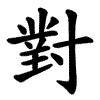對
| ||||||||
Translingual
| Stroke order | |||
|---|---|---|---|
 | |||
| Traditional | 對 |
|---|---|
| Shinjitai | 対 |
| Simplified | 对 |
Han character
對 (radical 41, 寸+11, 14 strokes, cangjie input 廿土木戈 (TGDI), four-corner 34100, composition ⿰⿱业𦍌寸)
Related characters
- 対 (Japanese shinjitai)
- 对 (Simplified Chinese)
References
- KangXi: page 296, character 7
- Dai Kanwa Jiten: character 7457
- Hanyu Da Zidian: volume 1, page 511, character 9
- Unihan data for U+5C0D
Chinese
| trad. | 對 | |
|---|---|---|
| simp. | 对 | |
Glyph origin
| Historical forms of the character 對 | ||
|---|---|---|
| Shang | Western Zhou | Shuowen Jiezi (compiled in Han) |
| Oracle bone script | Bronze inscriptions | Small seal script |
 |
 |
 |
| Characters in the same phonetic series (對) (Zhengzhang, 2003) | |
|---|---|
| Old Chinese | |
| 對 | *tuːbs |
| 轛 | *tuːbs, *tubs |
| 薱 | *duːbs |
| 濧 | *duːbs |
| 懟 | *dubs |
In the oracle bone and bronze scripts, it was an ideogrammic compound (會意) : 丵 (“tool for digging”) + 土 (“earth”) + 又 (“hand”). The original meaning of the character is unclear, but it may be “to develop (land)”. It was later borrowed for “to reply”. Compare 封, 邦.
In the seal script, 又 has become the related 寸. Shuowen has two seal script forms for this character: 𡭊 (main form) and 對 (alternative form). The main form, which has a 口 (“mouth”), was probably created to specialize the character to signify “to reply”, but this form was not inherited in later scripts. Shuowen interprets the latter form (shown above) as a form that Emperor Wen of Han created by replacing 口 with 士 (“soldier; warrior”) because many of the replies were untruthful (just lip service), but it is more likely that 士 is a corruption of 土.
Pronunciation
Definitions
對
- correct; true; right
- towards; to
-
- 難忘妳對我那種體貼入微 時時刻刻腦海中都緊記 [Literary Cantonese, trad.]
- naan4 mong4 nei5 deoi3 ngo5 naa5 zung2 tai2 tip3 jap6 mei4; si4 si4 hak1 hak1 nou5 hoi2 zung1 dou1 gan2 gei3 [Jyutping]
- I can't forget that attention you gave me; it's still stuck fast in my mind all the time
难忘你对我那种体贴入微 时时刻刻脑海中都紧记 [Literary Cantonese, simp.]
- to treat
- paired; contrasting
- to match
- to respond; to answer
- to check; to verify
- 對賬 / 对账 ― duìzhàng ― to check bills
- Classifier for pairs of objects: pair
- according to
- versus; vs.
- (Min Nan) from
Synonyms
| Dialectal synonyms of 對 (“correct”) [map] | ||
|---|---|---|
| Variety | Location | Words |
| Formal (Written Standard Chinese) | 正確 | |
| Mandarin | Beijing | 對 |
| Taiwan | 對 | |
| Tianjin | 對 | |
| Xi'an | 對 | |
| Wuhan | 對 | |
| Chengdu | 對 | |
| Yangzhou | 對 | |
| Hefei | 對 | |
| Malaysia | 對 | |
| Singapore | 對 | |
| Cantonese | Guangzhou | 啱 |
| Hong Kong | 啱 | |
| Taishan | 啱 | |
| Yangjiang | 著, 啱 | |
| Gan | Nanchang | 對 |
| Hakka | Meixian | 著, 啱 |
| Xingning | 著 | |
| Huidong (Daling) | 著 | |
| Qujiang | 著 | |
| Lianshan (Xiaosanjiang) | 著 | |
| Changting | 著 | |
| Pingyu | 著 | |
| Wuping | 著 | |
| Liancheng | 著 | |
| Ninghua | 著 | |
| Ruijin | 著 | |
| Shicheng | 著 | |
| Shangyou | 著 | |
| Miaoli (N. Sixian) | 著 | |
| Liudui (S. Sixian) | 著 | |
| Hsinchu (Hailu) | 著 | |
| Dongshi (Dabu) | 著 | |
| Hsinchu (Raoping) | 著 | |
| Yunlin (Zhao'an) | 著 | |
| Jin | Taiyuan | 對 |
| Min Bei | Jian'ou | 對, 𣍐錯 |
| Min Dong | Fuzhou | 著, 無綻 |
| Min Nan | Xiamen | 著 |
| Quanzhou | 著 | |
| Zhangzhou | 著 | |
| Taipei | 著 | |
| Kaohsiung | 著 | |
| Penang | 著 | |
| Singapore | 著 | |
| Philippines (Manila) | 著 | |
| Chaozhou | 對, 著 | |
| Shantou | 對, 著 | |
| Wu | Shanghai | 對 |
| Suzhou | 對 | |
| Wenzhou | 對 | |
| Xiang | Changsha | 對 |
| Shuangfeng | 對, 是 | |
Compounds
|
|
|
Further reading
- “Entry #10475”, in 臺灣閩南語常用詞辭典 [Dictionary of Frequently-Used Taiwan Minnan] (in Chinese and Min Nan), Ministry of Education, R.O.C., 2011.
Japanese
| 対 | |
| 對 |
Readings
- Go-on: たい (tai)
- Kan-on: たい (tai)
- Tō-on: つい (tsui)←つゐ (tuwi, historical)
- Kun: あいて (aite, 對)←あひて (afite, historical); こたえる (kotaeru, 對える)←こたへる (kotaferu, historical); そろい (soroi, 對い)←そろひ (sorofi, historical); つれあい (tsureai, 對い)←つれあひ (tureafi, historical); ならぶ (narabu, 對ぶ); むかう (mukau, 對かう)←むかふ (mukafu, historical)
- Nanori: つし (tsushi)